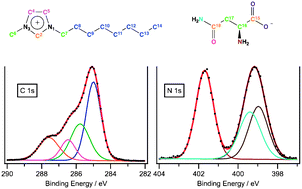Amino acid-based ionic liquids: using XPS to probe the electronic environment via binding energies†
Abstract
Here we report the synthesis and characterisation by

* Corresponding authors
a
School of Chemistry, The University of Nottingham, Nottingham NG7 2RD, UK
E-mail:
peter.licence@nottingham.ac.uk
Tel: +44 115 8466176
Here we report the synthesis and characterisation by

 Please wait while we load your content...
Something went wrong. Try again?
Please wait while we load your content...
Something went wrong. Try again?
B. B. Hurisso, K. R. J. Lovelock and P. Licence, Phys. Chem. Chem. Phys., 2011, 13, 17737 DOI: 10.1039/C1CP21763A
To request permission to reproduce material from this article, please go to the Copyright Clearance Center request page.
If you are an author contributing to an RSC publication, you do not need to request permission provided correct acknowledgement is given.
If you are the author of this article, you do not need to request permission to reproduce figures and diagrams provided correct acknowledgement is given. If you want to reproduce the whole article in a third-party publication (excluding your thesis/dissertation for which permission is not required) please go to the Copyright Clearance Center request page.
Read more about how to correctly acknowledge RSC content.
 Fetching data from CrossRef.
Fetching data from CrossRef.
This may take some time to load.
Loading related content
